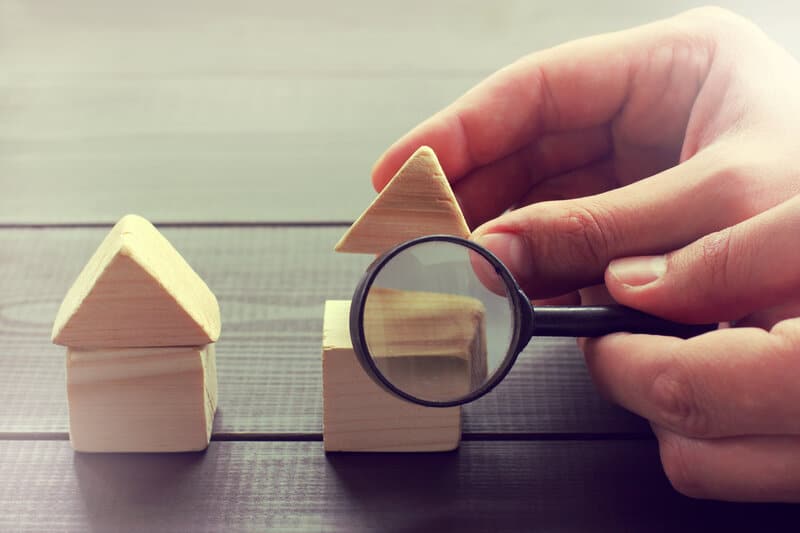
When did you last schedule a roof inspection with a licensed Bay Area roofing contractor?
Any high-quality roofing materials manufacturer considers routine inspections a part of their recommended maintenance steps, and your insurance carrier may also require proof of regular inspection when filing a repair or replacement claim.
The Steps We Take During An Annual Roof Inspection
Your annual roof inspection is designed to catch red flags that will lead to roof leaks or more extensive repair and replacement damages down the road if they aren’t remedied now. Your small investment in annual inspections and maintenance keeps your roof in top shape and saves you thousands of dollars throughout its lifetime.
Here are the steps we take when performing a roof inspection.
Take a look at the roof from the ground
First, we give your roof the once-over from the ground. As we walk the perimeter of your home or business, we’ll look for signs of:
- Sagging.
- Uneven slopes.
- Obvious patches with missing or severely damaged shingles.
- Issues with the gutters and downspouts.
We’ll also do a ground check, looking for any roofing parts or nails/screws around the perimeter of the building, which signify things are coming detached from the roof structure.
We’ll do a tour of your attic
The roof is one component in a system that includes the attic, insulation, and ventilation. Before we look at the roof’s surface, we look inside your attic. We’ll look for evidence of:
- Leaks.
- Moisture, condensation, or water damage.
- Adequate ventilation.
- Sufficient insulation.
- Poorly sealed penetrations.
- Ringers (nails that have punched through the roof deck into the attic).
Some of these issues we can address while we’re there – or we’ll schedule a date to come back for necessary repairs. Others should be handled by industry-specific contractors, so we’ll make the repair recommendations and can provide referrals to reputable local contractors if needed.
Assess how many roof layers there are
Sometimes, a “new roof” is laid on top of an old one. This is no longer considered a best practice. If we see evidence of multiple roof layers, we’ll recommend a full roof replacement once the newest layer is ready to retire.
Keep in mind that the more layers we have to remove, the higher the labor bill. So, while some lesser-quality contractors may advocate for “saving money” by adding a new layer, all you’re doing is increasing your chances of more serious roof issues and putting off the expense until “the next time.”
Inspect the roof deck
The roof deck is the base layer of the roof. A well-constructed roof deck can last for decades if future repairs and outer roof layers are built well. If the roof deck is at all soft or spongy, or if we notice areas of the roof that are caving in or uneven, your roof deck probably needs to be replaced.
Look at roof ventilation
We mentioned that ventilation is an important part of roofing systems system. Some home ventilation is installed/maintained by other contractors, like hood vents, bathroom or plumbing vents, etc. However, your roof is designed with specific ventilation systems – depending on the roof’s shape, size, and design – that increase airflow and mitigate moisture issues.
We’ll examine your roof ventilation, ensure it’s free of obstructions, and ensure other ventilation penetrations are securely fastened and sealed.
Inspect all other roof penetrations
Most roofs have several penetrations, ranging from the chimney to skylights, solar tubes, and the above ventilation systems. We inspect them all to ensure they’re in good shape, well-sealed, not pulling loose or missing fasteners, and that the flashing is still intact.
The roof is most vulnerable to leaks or moisture control issues wherever anything penetrates its surface, so inspecting penetrations is a top priority during any roof inspection or maintenance appointment.
Examine the roof’s surface
While we’re up there, we’ll walk the entire surface and look for any signs of shingle damage, lifting, cracking, etc. If you have wood shingles or a metal roof, we’ll make sure the surface looks properly sealed and corrosion-free. We also remove any branches, twigs, or leaf debris to prevent it from harboring moisture or making its way into the gutters the next time it rains.
We’ll also let you know if we see mold, algae, or moss growth and will clean that off to prevent accelerated wear or erosion of your roofing materials.
Look at the condition of drip edges, gutters and downspouts
Typically, drip edges, gutters, and downspouts are replaced along with a roof, so the roof and drainage system are the same age. This isn’t always the case. Dropped branches or storm damage may have dented or knocked loose certain drainage system sections.
We’ll clean and flush the drainage system to ensure there are no overflows and that water flows freely around the roof’s perimeter and down the spouts.
Schedule Your Overdue Roof Inspection With Pacific Coast Roofing
Is your roof overdue for a professional inspection or a complete annual maintenance visit?
Contact us here at Pacific Coast Roofing. Our inspections are competitively priced, and the small amount you pay can save you thousands of dollars – and extend your roof’s lifetime – because we catch small roofing issues before they cause significant damage. Partnering with PCR means your roof will be well-taken care of for the rest of its life.

